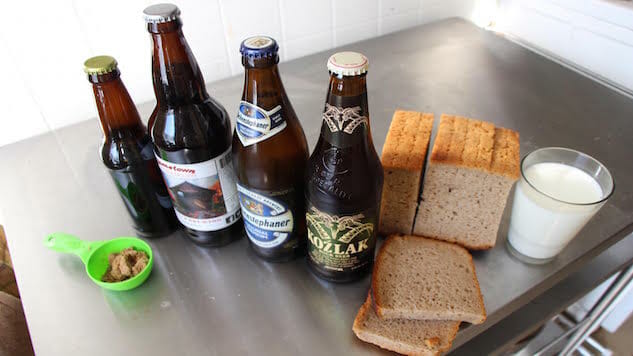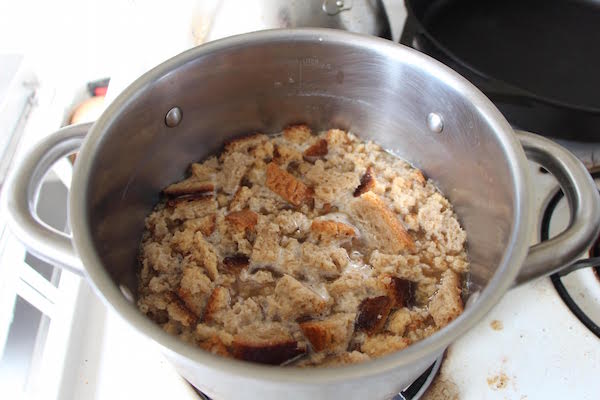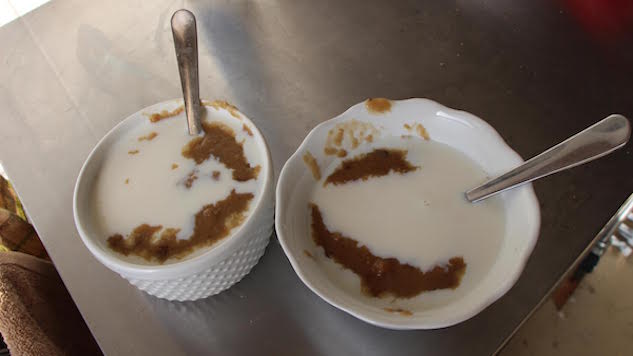Beer Porridge Finds a Fresh Update Four Centuries after Its New York Debut
Photos by Molly Jean Bennett Food Features
Porridge fervor is on the rise. So are all things hygge. But it wasn’t in the context of trendy ancient grains or Northern European coziness that I first encountered beer porridge—I read about it in a history book. The book in question was Joy Santofler’s excellent Food City: Four Centuries of Food-Making in New York. “Dutch desires structured the enduring pyramid of food-making in New York—bread, meat, sugar and especially beer,” she writes in the introduction. “The settlers poured lager over their porridge.” Lager over porridge. My brain immediately supplied the bleak visual of a can of Bud Light being emptied onto a bowl of lumpy oatmeal. As with many things that initially disgust me, I wanted to know more.
Santlofer doesn’t say more about beer porridge in particular, but there’s plenty to glean from her description of the Dutch settlers’ diet. Initially, they rejected locally available foods and relied on imports from the Dust West India Company. According to Santlofer, many of the Dutch who touched down in New Amsterdam in the early 1600s came to trade fur, tobacco and lumber. They had no interest in learning to farm, hunt or gather.
Eventually, though, as the settlement grew and more people contemplated longer stays, they began to grow grain in order to produce locally the beer and fresh bread they missed from home. The area at the present-day intersection of John and Williams Streets was a wheat field called Golden Hill. Settlers also traded with the local Lenape tribe for corn, from which they might have made a porridge called suppawn. Did they pour beer over it? Hard to say. There are a great many versions of Northern European beer porridge that the Dutch might have brought to the Americas. The porridge would have likely been made with low-alcohol “small beer” that men, women and children drank all day because it was safer than water. Refined sugar would probably not have been an ingredient before the mid-1600s, when the escalation of the brutal Caribbean sugar trade made it accessible to more consumers. While I wasn’t able to arrive at the exact porridge of old New York, Santlofer peaked my curiosity in the beer porridge landscape.
Øllebrød at the Great Northern Food Hall
I first set out to try a professional variety. The much-lauded Great Northern Food Hall, I learned, is serving up a fresh take on Danish beer porridge in Grand Central Terminal. Their dessert porridge, called øllebrød, is the most interesting thing I’ve eaten in recent memory. The porridge itself is cool and smooth, almost like a pudding, with occasional clumps of chewy rye bread. With malt and citrus flavors dominating, it’s hard to fully discern beer’s contribution. The toppings are where things get really wild. First, there’s the mild, silky cloud of vanilla milk foam. Then come the sea buckthorn berries—tiny orange bursts of tartness. Finally, the porridge is sprinkled with a hailstorm of crunchy caramelized rye crumbs and tarragon sugar. The overall effect is a dish that’s incredibly complex in both texture and flavor. Verdict: a delectable treat.
Homemade Norwegian Beer Porridge Photo by Molly Jean Bennett
Photo by Molly Jean Bennett
While delicious, the Great Northern’s inventive øllebrød bears little reasonable similarity to the beer porridge that sustained Dutch settlers. Curious about more workaday versions, I took to the kitchen. First I tried a recipe adapted from a Norwegian cookbook published in 1854. Like the Great Northern’s øllebrød, this porridge begins with a base of stale rye bread soaked in beer—four whole cups of it. I chose Weihenstephaner Original, which I hoped would be a neutral base. The recipe says to mix the bread, beer, egg and sugar together and bring them to a boil, then simmer.
As it cooked, the porridge smelled rich and malty, much like the grain steeping step of brewing beer. Very promising. I won’t be coy here, though—this porridge turned out wretched. I could only manage a few spoonfuls before tossing it out. It was too sweet and too bitter all at once. Reminiscent of Malt-O-Meal hot cereal, the texture wasn’t bad. But the flavor? Good Lorax no. I love beer and I like hot cereal well enough, but this particular combination brought out the worst qualities in both. I can see how this filling, inexpensive breakfast would be attractive to someone headed out for a day of farmwork in subzero temperatures, but I couldn’t personally stomach it. Verdict: never again.
Homemade Bierpap Photo by Molly Jean Bennett
Photo by Molly Jean Bennett
For my next beer porridge experiment, I attempted a Dutch variety called bierpap. This one looked like it might be more appetizing based on the ingredients. The recipe calls for dark beer—a much better companion for milk—so I used a homebrewed chocolate stout. Thinner and more cocoa-esque than the øllebrød and the Norwegian porridge, bierpap has a reputation as a comforting, before bed drink. While not as disgusting as the Norwegian rye porridge, my bierpap did not impress. It didn’t help that my subpar flour-whisking technique left me with a lumpy porridge. Beyond that, though, I am not a big milk fan and would rather have the stout by itself. Verdict: not my cup of pap, but I can see why some people like it.
While my own attempts at making classic beer porridges were fairly disastrous, I don’t think they constitute a referendum on the food itself. Renditions with more complex flavor profiles, like this the Great Northern’s øllebrød and this rhubarb rye beer porridge, seem much more promising. I’ll be sure to try it out when rhubarb season rolls around. Whether or not beer porridge is poised for a New York comeback, I’ll be ready. Life’s too short for boring porridge.
Molly Jean Bennett is a writer and multimedia producer based in New York City. Her essays, poems, and strongly worded letters have appeared in McSweeney’s Internet Tendency, Atlas Obscura, VICE, and elsewhere.